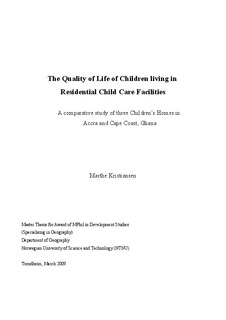| dc.description.abstract | This study is concerned with aspects of the quality of life of children in three residential child care facilities (Children's Homes) in Accra and Cape Coast Municipality. It is comparative in its nature and aims to investigate how the material and social structures and supplies of the Children’s Homes contribute to similarities and dissimilarities in aspects of the children’s quality of life, both between and within the homes. The theoretical framework of the study is based on a quality of life approach, where quality of life is seen as an all-embracing conception, which includes a basic needs approach (BNA) and is supplemented by a subjective well-being approach (SWB). The theory of structuration is used to understand how material and social structures and supplies at the Children's Homes affect aspects of the children’s quality of life. The theory of structuration is a framework to investigate to what degree the children are able to act as competent social actors. The study was carried out in two different regions; the Greater Accra Region and in the Central Region at three Children's Homes. Osu Children’s Home (governmental) is located in Accra, the capital of Ghana, Ahotokurom (private) in a peri-urban area outside the city of Cape Coast and Lighthouse Children’s Home (private) is located just outside the Cape Coast city centre. Methodologically this study applies a qualitative approach and includes the triangulation of a variety of qualitative instruments of data collection. The data has been collected through 14 interviews with children from the ages of twelve to nineteen and eight key-informant interviews with the staff at the Children's Homes, two interviews with additional informants, as well as observations and some quantitative data. The thesis concludes that the material and social structures and supplies available at the Children’s Homes have strong bearings on the children’s lives and aspects of their quality of life. The Children’s Homes represents sets of structures that both enable and restrict the children to act as competent social actors. Even though the material and social structures and supplies at the homes determine much of the children’s lives, the children have some degree of freedom to act within these structures and are able to influence their own lives. The degree of freedom to act as competent social actors varies between the homes. At Osu there exists a stronger accumulation of conditions creating poorer aspects of quality of life, such as poor food, shelter, clothing, education, safety, leisure, love and belonging and social networks. The children at Ahotokurom and Lighthouse generally enjoy conditions creating better aspects of quality of life, the only exception being perhaps healthcare. This difference seems to be connected to the type of ownership, gatekeeping, finances, location and contact with the local community. | nb_NO |
